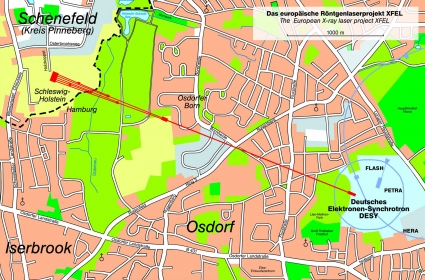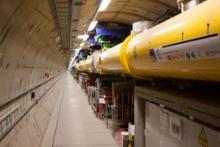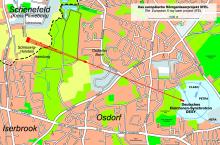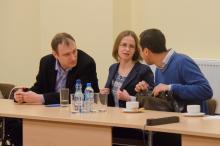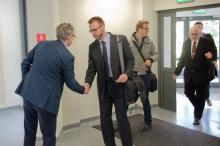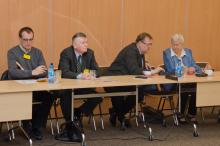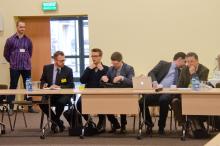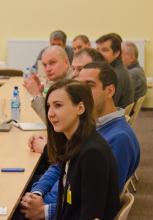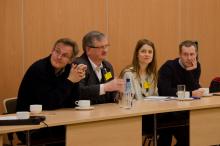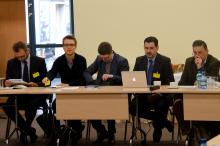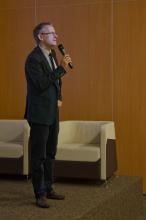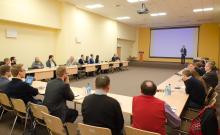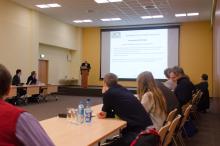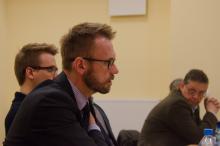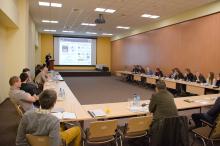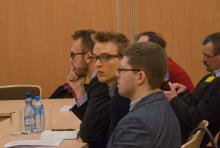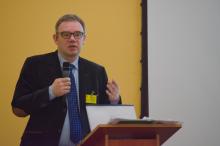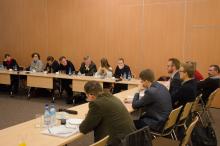Scientists interested in research on beams to be generated by European XFEL (X-ray Free Electron Laser) met in Świerk on April 26, 2016. NCBJ is a shareholder of an international project to develop that unique large research facility worth more than 1.22 billion Euro. Poland will soon co-own all future discoveries and results of experiments performed at the facility.
European XFEL (X-ray free electron laser) currently under development near DESY (Deutsches Elektronen Synchrotron) in Hamburg will be among the most modern large research facilities in the world. A few tens Polish researchers interested in European XFEL beams who met in Świerk represented Polish Academy of Sciences (PAS) Institute of Physics and Institute of Biochemistry & Biophysics, International Institute of Molecular and Cell Biology in Warsaw, Warsaw University of Life Sciences (SGGW), Warsaw University Chemistry Faculty, Warsaw University of Technology Physics Faculty, NCBJ, AGH University of Science & Technology, The Jan Kochanowski University in Kielce, University of Bialystok, Military University of Technology in Warsaw. They conduct their research in fields such as physics, bio-physic, bio-chemistry, material science, crystallography, laser technologies. The meeting was also attended by some representatives of Ministry of Science & Higher Education i.e. institution that will be evaluating future applications of Polish scientists for grants to finance research projects to be conducted at the European XFEL facility.
“European XFEL laser to be put in operation in 2017 will make possible experiments we could only dream of until recently. We hope that the experiments will help to reveal some knowledge so far inaccessible, particularly in areas such as innovative drugs, molecular mechanisms of cell functioning, course of chemical reactions, development of new engineering materials.” – said Professor Krzysztof Kurek, NCBJ Director General – "Benefits attributable to participation in the project are numerous, even if the facility is still in its development phase. A team of experts in safe running large cryogenic systems developed in Wroclaw University of Technology may be an excellent example”.
NCBJ, one of 12 European XFEL GmbH shareholders from 11 countries, has been cooperating with several domestic and foreign subcontractors. As the first among shareholders it has successfully accomplished majority of the assigned tasks. The “Wroclaw group” (Wroclaw University of Technology, Technology Park in Wroclaw, the Kriosystem company) was responsible for development of a cryogenic line to transport liquid helium in the supercritical state and two cryostats necessary to test niobium superconducting resonators (key accelerator components). Scientists/engineers/technicians from PAS Institute of Nuclear Physics in Cracow have tested 816 superconducting 1.3 kHz resonators and more than 80% of complete modules of the accelerator before their deployment in the tunnel. NCBJ has delivered 108 high order mode absorbers, 1648 mode couplers, and 824 test antennas necessary to diagnose distribution of electromagnetic field inside accelerating structures. Residues of gases remaining in ultra high vacuum of the annealed absorbers containing ceramic rings were analysed by NCBJ specialists for the first time; so far the NCBJ-delivered absorbers were tested by DESY experts in Hamburg. It must be pointed out that vacuum cleanliness requirements are much more stringent in superconducting accelerators then in classical (non-superconducting) ones including practically all commercial accelerators. Therefore every component of a superconducting accelerator must be rigorously tested.
European X-ray free electron laser will be among the largest research facilities in the world. Electron accelerator has been deployed in a 5.8 km long tunnel routed north-west from the DESY Hamburg site. Equipment responsible for generation of coherent beams of X-ray radiation have been deployed near the end of the tunnel. Research equipment will be deployed in a hall erected at the end of the tunnel. According to a contract reached between NCBJ and European XFEL GmbH in December 2015, NCBJ is going to deliver some components of the control circuitry to be deployed at the end of the X-ray optical lines and within the first six research set-ups. Contract value is a few hundred thousand Euro.
Construction of the European XFEL laser is to be finished before the end of 2016, the first delivery of the beam to the users is scheduled for mid-2017. The laser will generate 27,000 ultra-short flashes of X-rays per second. Intensity of each flash will be billion times higher than intensity of beams emitted by the most bright conventional sources of X-rays. Other advantages of free electron lasers in comparison with conventional lasers include an extremely short duration of each flash, and a capability to tune wavelength of the emitted rays in a wide range from millimetres (the so-called Teraherz radiation) down to nanometres (X-rays). High intensity is of particular interest in experiments requiring a large number of photons in view of rare occurrence rate of the interaction of interest e.g. experiments on highly diluted biological samples. It also helps to efficiently radiation-modify surfaces of engineering materials where the process efficiency is proportional to average power of the laser. It is expected that free electron laser will significantly impact numerous research fields (solid state physics, material sciences, chemistry, biochemistry, biology, medicine…). Availability of new extremely bright sources of X-rays of some unique properties will surely help to develop new methods and technologies of the future, capable to deeply transform our lives in many aspects.
Visit the www.xfel.eu Website to learn more about the European XFEL project.
